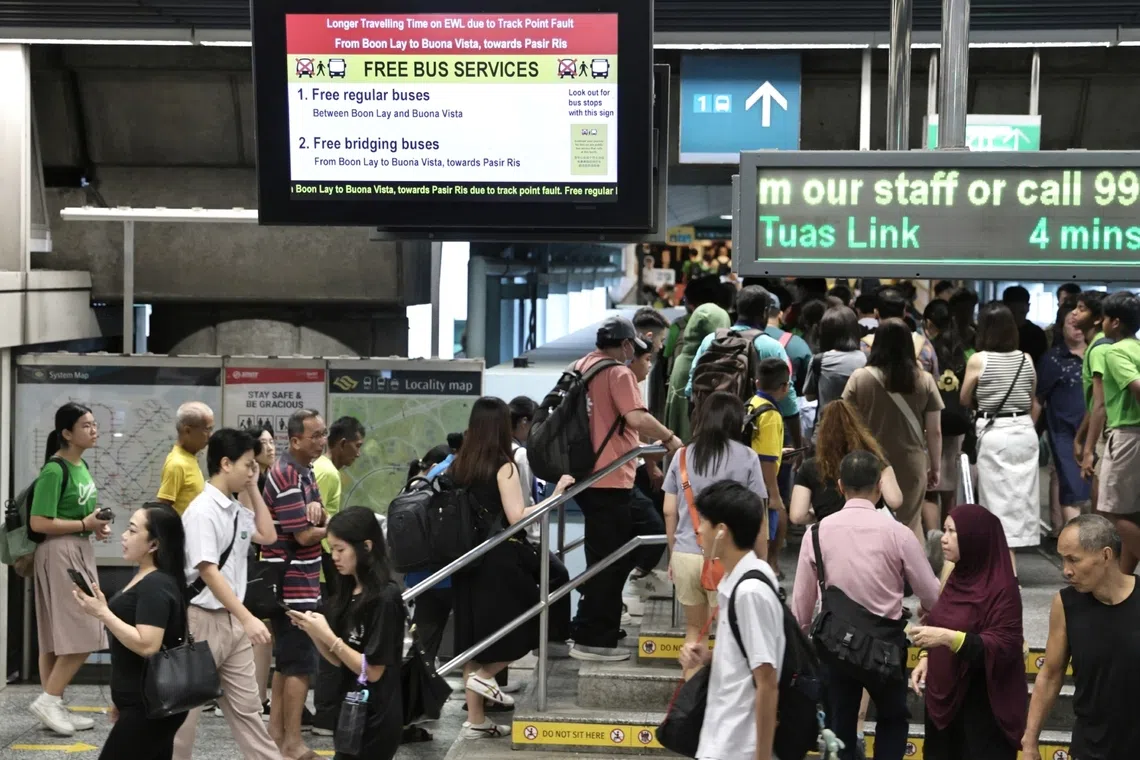MRT reliability dips for second straight month in Sept; North-South Line the least reliable
Sign up now: Get ST's newsletters delivered to your inbox

The East-West Line came in third, posting 1.7 million train-km between delays, an increase from 1.68 million train-km the previous month.
PHOTO: ST FILE
Follow topic:
- MRT reliability dipped in September, with the average distance travelled between delays falling to 1.67 million train-km.
- The North-South Line's reliability decreased due to two disruptions, making it the least reliable line in September.
- LTA now publishes monthly rail reliability reports for improved transparency, following recent rail disruptions.
AI generated
SINGAPORE – The MRT network’s reliability fell for the second consecutive month as at the end of September, compared with August, based on the latest figures from the Land Transport Authority (LTA) released on Nov 14.
On average, MRT trains clocked 1.67 million train-km between delays that lasted more than five minutes between October 2024 and September 2025. This is down from an average of 1.74 million train-km between September 2024 and August 2025.
For the first time, LTA on Nov 14 also published data on three new indicators of reliability and passenger experience
The other indicators showed the impact of train disruptions on passengers, and the proportion of train services that operated according to schedule.
In September, there were two major disruptions exceeding 30 minutes on the MRT network – one on the Circle Line (CCL) on Sept 1, on Sept 16. three-hour disruption on the Punggol LRT line
The North-South Line (NSL), run by public transport operator SMRT, was the only MRT line that fared worse than the moving average in the previous month, according to the LTA report.
It clocked 1.24 million train-km between delays as at September, down from 1.65 million train-km in August, becoming the least reliable line of the MRT network.
A disruption from Woodlands to Yishun
Around noon on Sept 14, another disruption took place from Newton to Ang Mo Kio
In both these instances, SMRT was able to resume services partially in under 30 minutes.
The Downtown Line (DTL) remained the best-performing among the five lines whose figures were included, logging 2.77 million train-km between delays as at September, an improvement from 2.76 million train-km in August.
In second place was the North East Line (NEL), which experienced an increase in reliability, having travelled 2.16 million train-km between delays, up from 2.14 million train-km.
Public transport operator SBS Transit (SBST) operates both the DTL and NEL.

The EWL emerged third, posting 1.7 million train-km between delays, an increase from 1.68 million train-km the previous month.
The CCL was no longer the least reliable line, coming in second-to-last with 1.49 million train-km travelled between delays, up from 1.25 million train-km.
SMRT runs the EWL and CCL.
The figures are based on a 12-month moving average of mean kilometres between failure (MKBF), which captures the distance a train travels before encountering a delay of more than five minutes. It does not account for the severity of disruptions.
Singapore has an MKBF target of one million train-km for the entire MRT network.
This is the second monthly rail reliability report that LTA has released, as it moves away from publishing these numbers quarterly, in an effort to improve transparency and accountability.
The SMRT-run Thomson-East Coast Line (TEL) was not factored into the overall reliability figure as it is not fully open. It will be included in the overall MKBF figure about one year after its fifth phase – comprising the Bedok South and Sungei Bedok stations – opens in the second half of 2026.
Reliability figures for TEL showed that the newest rail line posted 287,000 train-km between delays as at September, down from 311,000 train-km in August.
The authority reiterated that the teething issues for TEL will take time to stabilise as they require LTA and SMRT to work with the original equipment manufacturers to resolve.
While these teething issues – including problems with its signalling system – could result in delays, LTA pointed out that the nature of such delays is different from those encountered during the operation of mature rail lines.
On the LRT front, overall reliability increased, with an average of 474,000 car-km recorded between delays as at September, up from 420,000 car-km in August.
The Sengkang-Punggol LRT, operated by SBST, clocked 842,000 car-km between delays, up from 840,000 car-km in August.
The SMRT-run Bukit Panjang LRT posted 253,000 car-km between delays, up from the 209,000 car-km recorded in August.
With at least 15 rail disruptions between July and September, the reliability of the train network has been in the public spotlight.
The spate of breakdowns have prompted the Government to form a rail reliability task force


